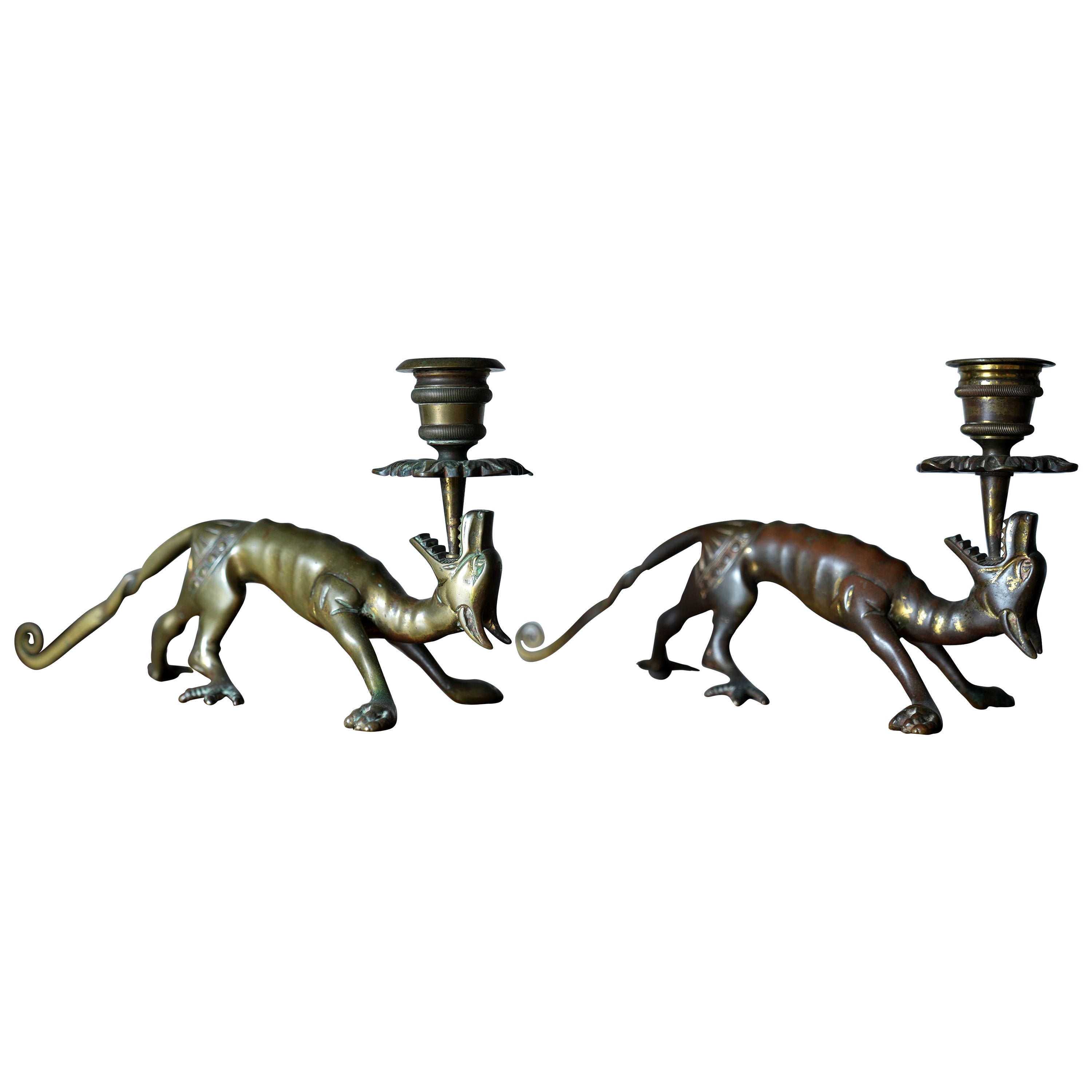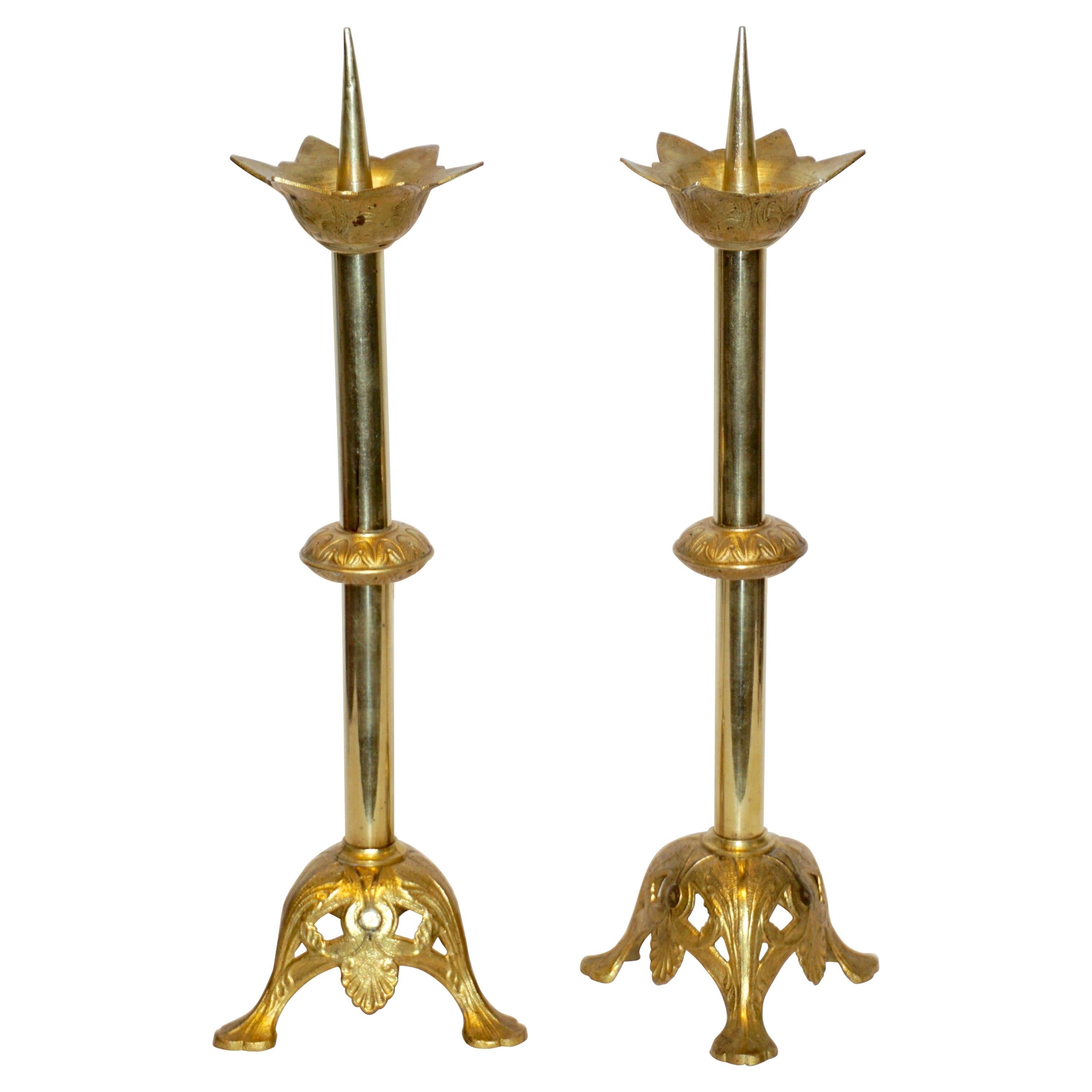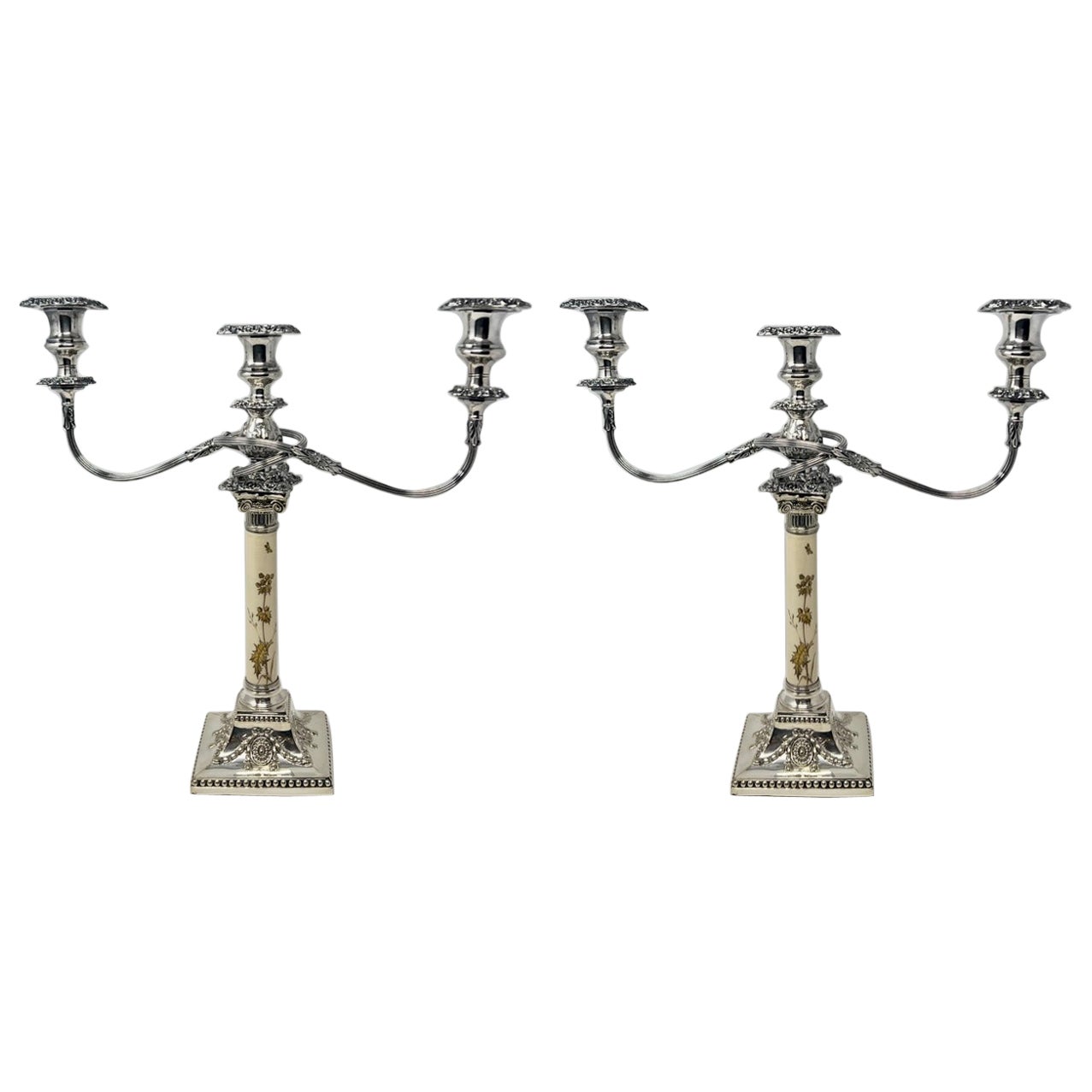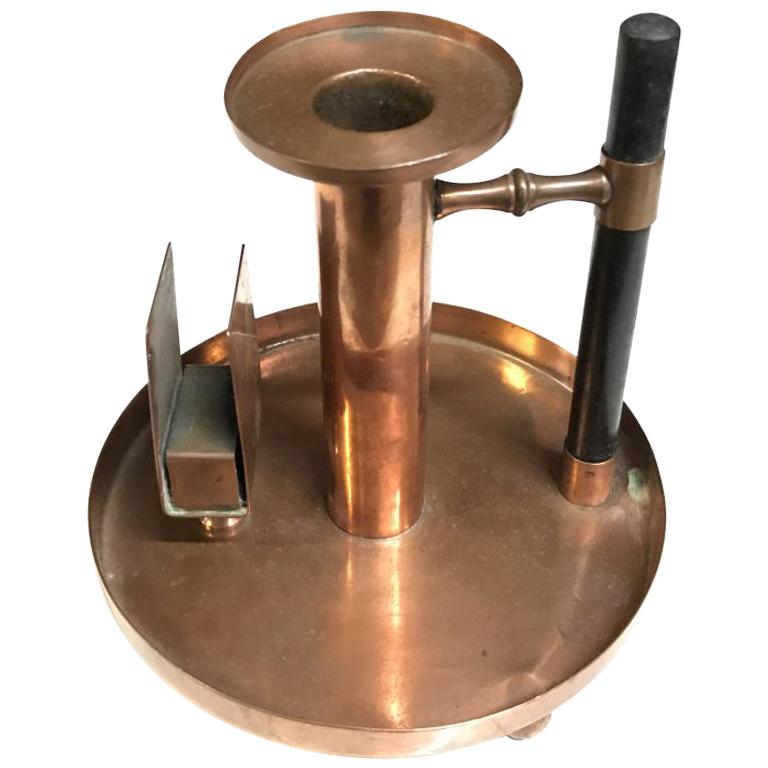Items Similar to Aesthetic Movement Pair of Bronze Candlesticks in Manner of Tiffany, ca. 1880s
Want more images or videos?
Request additional images or videos from the seller
1 of 10
Aesthetic Movement Pair of Bronze Candlesticks in Manner of Tiffany, ca. 1880s
About the Item
American Aesthetic Movement
Pair of Bronze Candlesticks
in Manner of Tiffany
ca. 1880s
DIMENSIONS
Height: 18.25 inches
Width: 3.25 inches
Depth: 3.25 inches
ABOUT
This elegant pair of tall, graceful, perfectly shaped bronze candle holders are executed in the Tiffany style and are a very representative example of the applied art decorative object of the Aesthetic Movement era; and could be dated back to 1880s.
From 1860 to 1900, the Aesthetic Movement initiated sweeping artistic and design changes and its modern concepts of middle-class lifestyle and domestic environment reverberate even into our own time.
There were certain qualities and several characteristics of the Aesthetic Movement,
shared among many of its adherents, such as:
- Art for art's sake.
- Emphasis on aesthetic beauty.
- Natural motifs.
- Rejection of Victorian stuffiness.
More than a movement, Aestheticism was a lifestyle получивший саоме широкое распостранение как среди буржуазии, так и среди аристократии. Oscar Wilde is considered the father of aesthetics, which is the literary study of beauty in its natural form and its human perception. Oscar Wilde was one of the first writers of the nineteenth century who started to question the literary structures of classic and religious literature.
The aesthetic movement stood in stark and sometimes shocking contrast to the crass materialism of Britain in the 19th century. "Art for art's sake" was its battle cry, the main slogan that originated with the French poet Théophile Gautier.
During the Aesthetic Movement, aesthetic design was influenced by eclectic styles which fascinated the public. The attraction of unusual architecture and artistic qualities in everyday items such as a fan drove the direction of manufacturing and commercial ventures. Artful homes were popularized.
The Aesthetic movement denounced the sober morality and middle-class values that characterized the Victorian Age and embraced beauty as the chief pursuit of both art and life. The movement is often considered to have ended with Oscar Wilde's trials, which began in 1895.
- Dimensions:Height: 18.25 in (46.36 cm)Width: 3.25 in (8.26 cm)Depth: 3.25 in (8.26 cm)
- Style:Aesthetic Movement (Of the Period)
- Materials and Techniques:Bronze,Cast
- Place of Origin:
- Period:
- Date of Manufacture:ca. 1880s
- Condition:Wear consistent with age and use. We make our best effort to provide a fair and descriptive condition report. Please examine photos attentively for they are an important part of the description. Send us a message to request more details or discuss price.
- Seller Location:New York, NY
- Reference Number:1stDibs: LU2819337975482
About the Seller
5.0
Vetted Seller
These experienced sellers undergo a comprehensive evaluation by our team of in-house experts.
Established in 1993
1stDibs seller since 2017
68 sales on 1stDibs
Typical response time: 2 hours
- ShippingRetrieving quote...Ships From: New York, NY
- Return PolicyA return for this item may be initiated within 10 days of delivery.
More From This SellerView All
- WMF, German Jugenstil, a Pair of Copper & Brass Candlesticks, Ca. 1910By WMF IkoraLocated in New York, NYDETAILS Marked on bottom. WMF GmbH In 1853, mill owner Daniel Straub, together with the Schweizer brothers, Louis and Friedrich, established the Straub & Schweizer metal works in Geislingen an der Steige, Germany. Only a few years later in 1862, their silver-plated tableware and serving dishes were awarded a medal of distinction at the world exhibition in London. The company, originally called Metallwarenfabrik Straub & Schweizer, merged in 1880 with Ritter & Co - a producer of high end luxury items who were ahead of their time in silver plating technique. Instead of using the method of heat and mechanical pressure to plate their wares, Ritter dipped the item into a bath of silver which together with an electric current produced pieces that were finely and evenly covered in a layer of silver. This method of plating was called ‘Galvanisation’ and allowed more intricate and complex pieces to be plated. After several years both companies still faced financial problems and in 1880 they joined with the Wurttemberg Union Bank and the company was renamed “WMF” (Württembergische Metallwarenfabrik). From its founding as one company, WMF's growth was tremendous - acquiring more factories along the way, notably including "Orivit AG" and "Orion KM". By the end of the 1900's, they were the world's largest producer and exporter of household metalware. WMF started making glass in 1883 when a glass house was built at Geisslingen near Stuttgart to produce their own glass inserts. The original 1883 glass house was destroyed during the First World War and a new, more modern facility opened in 1922. The young glass designer Karl Wiedmann perfected the technique of iridized surfaces and the resulting "MYRA"- Kristall entered production in 1926. The same year also saw the beginning of the first "IKORA" glass - reputedly discovered by accident whilst correcting a Myra glass...Category
Vintage 1910s German Jugendstil Candlesticks
MaterialsBrass, Copper
- Pair of Japanese Patinated Bronze Candelabras, Meiji Period, ca. 1900Located in New York, NYThis most unusual pair of original 18th century Japanese patinated bronze candelabras, uniquely designed as branches of mountain flowers entangled by a dragon, are mounted on the con...Category
Antique Late 19th Century Japanese Japonisme Candelabras
MaterialsBronze
- Pair of American Rococo Revival Patinated Bronze Candelabras, Ca. 1825Located in New York, NYBronze, dark-brown patina, unmarked. Measures: Height: 23” Width: 14” The notion of an “American Rococo” seems a contradiction in terms. The very word rococo is as French as Camembert. It connotes a style that reigned along with Louis XV in the aristocratic decadence of the 18th Century. It was garlanded, nonchalant, associated with erotic marshmallow nudes by Francois Boucher and foppish courtiers costumed as shepherds pretending they understood Jean-Jacques Rousseau when all they really wanted was romantic dalliance in the formal gardens of Versailles. In the history of painting it produced but one great artist, Antoine Watteau. By contrast, Americans of the period are remembered as the flinty inheritors of New England Puritans, full of rectitude and having not a moment for furbelow or frippery. Such few painters as were around included hard-nosed realists like John Singleton Copley and Charles Willson Peale. Well, as it turns out, life once again acts according to the principle of paradox. There was an American rococo. It came to us indirectly via England disguised under the name Chippendale. Now for the first time the style receives comprehensive survey in the exhibition “American Rococo, 1750-1775: Elegance in Ornament.” Jointly organized by New York’s Metropolitan Museum and the Los Angeles County Museum of Art, it opens here Sundaywith a spread of some 170 works of decorative art and a conscientious catalogue with essays by Met and LACMA curators Morrison H. Heckscher and Leslie Greene Bowman. There are at least two ways of looking at the decorative arts. Connoisseurs appreciate their design and craftsmanship. Those of sociological bent examine objects of material culture for their revelations of history and the temper of the times. Actually neither view is complete without the other. Stylistically the rococo reveals a longing for intimacy in its small scale and an urge to organic nature in its love of stylized vines, tendrils, tiny flowers and seashells. If it were a new manner being promoted by Madison Avenue today it would probably be called “Baroque Lite.” There is an ease about the style that makes it airy, but it has an underlying formality that bespeaks lives of gentrified cultivation rather than beer-bellied sloth. It’s fascinating to examine the flintlock firearms on view and find these weapons of death shaped and decorated with the most exquisite care by wood carvers and metal engravers. All of this is completely consistent with the main currents of 18th-Century European thought. In France, Rousseau sang the virtues of nature and the noble savage like a present-day ecologist. In England, John Locke...Category
Antique 1820s American Rococo Revival Candelabras
MaterialsBronze
- Alfredo Castellani Att., Bronze & Marble Paperknife, ca. 1880sLocated in New York, NYAttributed to Alfredo Castellani Paperknife Patinated Bronze & Marble Italy, ca. 1880s ABOUT These Castellani paper cutters, paperknives or lette...Category
Antique 1880s Italian Renaissance Letter Openers
MaterialsBronze
- Pair of Mid-Century Modernist Anodized Brass Lotus Candlesticks, USA, 1950sLocated in New York, NYA duo of anodized brass candlesticks, each featuring a round base, stem and a lotus flower that contains a regular size candle. Manufactured in the USA during the 1960s. The cand...Category
Mid-20th Century American Mid-Century Modern Candlesticks
MaterialsBrass
- French Art Nouveau Grand Bronze Iris Candelabra, ca. 1900Located in New York, NYABOUT IRIS MOTIFS Iris motifs were popular during the Arts & Crafts movement. The genus of this easy-to-stylize flower has nearly 300 varieties that bloom in many colors—thus its nam...Category
Antique Early 1900s French Art Nouveau Candelabras
MaterialsBronze
You May Also Like
- Pair of Victorian Candlesticks Candleholders Antique, German, 1880sLocated in Nuernberg, DEVery rare set of two silver-plated candlesticks, Germany, 1880s. They have a very nice patina. A decorative addition to any room.Category
Antique 1880s German Victorian Candlesticks
MaterialsMetal, Silver Plate
- Aesthetic Bronze Dog CandlesticksLocated in Hudson, NYAesthetic Bronze Dog CandlesticksCategory
Early 20th Century Aesthetic Movement Candlesticks
MaterialsBronze
- 1880s French Baroque Revival Pair of Gilt Bronze Ormolu Pricket CandlesticksLocated in New York, NYFrench handcrafted gold color candle holders in gilt bronze with high-quality decoration, each with a Baroque Revival bronze base elegantly decorated with open fretwork and fitted wi...Category
Antique Late 19th Century French Baroque Revival Candlesticks
MaterialsOrmolu, Metal, Bronze, Copper
- Pair Estate English Aesthetic Movement Silver-Plated Candlesticks Circa 1950-60.Located in New Orleans, LAPair Estate English Aesthetic Movement Silver-Plated Candlesticks, Circa 1950-1960.Category
Mid-20th Century English Aesthetic Movement Candlesticks
MaterialsSilver Plate
- Townsend & Co Aesthetic Movement Brass and Copper Bamboo CandlesticksBy Townsend & Co.Located in Bishop's Stortford, HertfordshireA very stylish pair Townsend & Co Aesthetic Movement candlesticks with mock bamboo supports dating from circa 1890. The candlesticks are finely made with rounded stepped domed heavy ...Category
Antique Late 19th Century English Aesthetic Movement Candlesticks
MaterialsBrass
- WMF. An Aesthetic Movement Copper Chamber Candlestick in the Dr C Dresser StyleBy Christopher Dresser, WMF Württembergische MetallwarenfabrikLocated in London, GBWMF. An Aesthetic Movement Copper Chamber Candlestick and match book holder in the Dr C Dresser Style.Category
Antique Early 1900s German Aesthetic Movement Candlesticks
MaterialsCopper
Recently Viewed
View AllMore Ways To Browse
Shield Candleholder
French Altar Sticks
Skinny Candlesticks
Floral Brass Candle Holder
Iron Candlestick Rustic
Tiffany Elsa Peretti Candle
Midcentury Swedish Candle
Dorothy Thorpe Pretzel Lucite
Floor Candle Stick Holder
Double Candle Sticks
Saint Louis Crystal Candlesticks
Dansk Iron Candle Holder
Modern Pearl Drip
Antique Georgian Sconce
Tiffany And Co Chandelier New York
Tiffany Studios 1230
Tommy Parzinger Brass Candle Holders
Tortoiseshell Candlesticks





